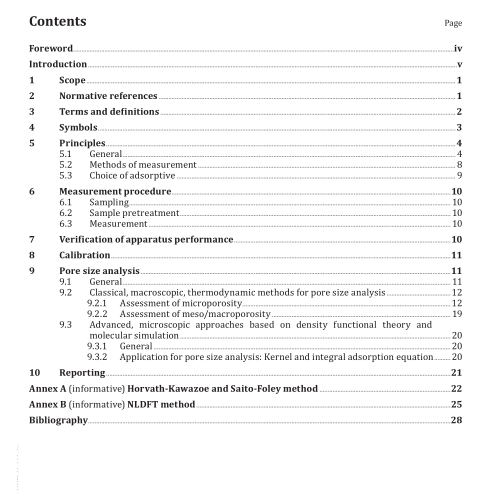ISO 15901-2:2022 pdf download.Pore size distribution and porosity of solid materials by mercury porosimetry and gas adsorption — Part 2: Analysis of nanopores by gas adsorption
5 Principles
5.1 General
Physisorption is a general phenomenon and occurs whenever an adsorbable gas (the adsorptive) is brought into contact with the surface of a solid (the adsorbent). The forces involved are the van der Waals forces. Physisorption in porous materials is governed by the interplay between the strength of fluid-wall and fluid-fluid interactions as well as the effects of confined pore space on the state of fluids in narrow pores. The effect of pore width on the interaction potential is demonstrated schematically in Figure 1 [8] .
Reversible Type I isotherms are given by microporous solids having relatively small external surfaces (e.g. some activated carbons, molecular sieve zeolites and certain porous oxides). Because the pore size is similar to the molecule diameter, the choice of the gas is decisive, i.e. the size of the gas molecule controls the accessibility of the pores, and hence affects the obtained porosity information. A Type I isotherm is concave to the relative pressure (i.e. p/p 0 axis) and the amount adsorbed approaches a limiting value. This limiting uptake is governed by the accessible micropore volume rather than by the internal surface area. A steep uptake at very low p/p 0 is due to enhanced adsorbent-adsorptive interactions in narrow micropores (micropores of molecular dimensions), resulting in micropore filling at very low p/p 0 . Type I(a) isotherms are given by microporous materials having mainly narrow micropores (of width ≤ 1 nm), which includes ultramicropores). A significant portion of the micropores is indicated by a large and steep increase of the isotherm near its origin and subsequent bending to a plateau. Type I(b) isotherms are found with materials having pore size distributions over a broader range including wider micropores (including supermicropores).
Type II isotherms are typically produced by solids which are non-porous or macroporous. Point B is often taken as indicative of the completion of the monolayer capacity. Type III isotherms are distinguished by a convexity towards the relative pressure axis.
These isotherms are found when weak gas-solid interactions occur on non-porous or macroporous solids (e.g. water adsorption on carbon surfaces). Type IV isotherms are found for mesoporous solids.
Type IV isotherms are given by mesoporous adsorbents (e.g. many oxide gels, industrial adsorbents and mesoporous molecular sieves). The adsorption behaviour in mesopores is determined by the adsorbent-adsorptive interactions and by the interactions between the molecules in the condensed state. In this case, the initial monolayer- multilayer adsorption on the mesopore walls, which takes the same path as the corresponding part of a Type II isotherm, is followed by pore condensation. Pore condensation is the phenomenon whereby a gas condenses to a liquid-like phase in a pore at a pressure p less than the saturation pressure p 0 of the bulk liquid. This leads to the appearance of a Type IV adsorption isotherm. A typical feature of Type IV isotherms is a final saturation plateau, of variable length (sometimes reduced to a mere inflexion point).
In the case of a Type IV(a) isotherm, capillary condensation is accompanied by hysteresis. This occurs when the pore width exceeds a certain critical width, which is dependent on the adsorption system and temperature (e.g. for nitrogen and argon adsorption in cylindrical pores at 77 K and 87 K, respectively, hysteresis starts to occur for pores wider than ~ 4 nm). With adsorbents having mesopores of smaller width, completely reversible Type IV(b) isotherms are observed. In principle, Type IV(b) isotherms are also given by conical and cylindrical mesopores that are closed at the tapered end.
Type V isotherms are characterized by a convexity to the relative pressure axis. Unlike Type III isotherms there occurs a point of inflection at higher relative pressures. Type V isotherms result from weak gas-solid interactions on microporous and mesoporous solids (e.g. water adsorption on micro-or mesoporous carbons).ISO 15901-2 pdf download.
